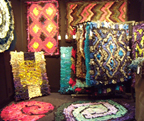- Whew! The surge of ideas has subsided just enough that I can start to get words all the way to the surface, but I have to stay out of the new drawing program or I’ll get lost in images all over again. Tried to write a few times earlier and couldn’t make it to paragraph format… just more graph paper.
The backstory: Last week, I found myself across the street from the Streets of Southpoint mall with some unscheduled time on my hands. I wandered over to the Barnes and Noble on the outskirts of the mall proper to see what might be new on the crafts racks. I thought at the time that this might be a major time waster, given that I had looked over the crafts section of the store at Triangle Town Center just a week before, but I’m a sucker for books and I’d already burned the gas. Any maybe the one I needed, that book that would change my life and make everything clear, was calling me…
It was.
The book I needed to find was Celtic Pieced Illusions, a quilting book by Karen Combs, published in 2006 by the American Quilting Society. Ms. Combs shows how to build a fabulous interlaced quilt design using only two basic squares, both of which can be easily knitted in the garter stitch I’m using for rugs. (Most quilting books about Celtic design use applique, not piecing.) The possibilities exploded in my mind while I paged through the book. It has taken not quite two weeks yet, and I’m losing my breath already to the possibilities ahead. 29 rugs completed or on needles and now an entirely new series appears. Just when you think you’d exhausted the possibilities (which isn’t even close to true because there are several variations of existing patterns I have plans to try).
I started playing on graph paper–first, building squares with 4×4 blocks and then moving to 1-block units because they could be drawn more quickly and took less graph paper. Interesting, and then I recalled that some of the patterns were reflected / flipped / glided (the various operations of symmetry). Reflecting by hand (pencil on paper) is slow (relatively); it was time for software.
Graphics software has been a sticking point as long as I’ve been on a PC; I grudgingly use a photo processing program and have taken a PhotoShop class but can hardly be called “graphics literate,” to any of the same extent I can hack around in MS Word or Excel. I’m not sure that’s going to change any time soon, but I found a free program that let me draw four different squares (two each of the two basic squares shown in the quilting book, crossing vertically and horizontally for one pair and angling in both directions for the other)(a more literate user would know how to do this using the software’s capabilities, but brute force also works much of the time) and then start pasting them into rug patterns.
Group / copy / paste / transform / group again / adjust size. Oh. My. Lord.
Earth to knitter: The largest rug to date was built on an 8×8 grid; designing for 16 units square is pushing the limits of the technology the darn thing will be too heavy to hold itself together…. But a knitter’s reach should exceed her grasp, or what’s a heaven for? (Isn’t that the way it goes?)
All of a sudden, many of the patterns generally known as “Oriental” are within my grasp, and in the lightly shaded grey of my on-line designs, I can see how the color manipulation can work. (I don’t yet know how to put the color in on-line and am planning to print grey-scale and use colored pencil.) Furthermore, I see a distinction in ease-of-knitting. While the Celtic interlaced patterns are fascinating and deserve attention, knitting a two-colored cross square is either intarsia, or seaming (three stripes, two vertical and one horizontal (this needs pictures and non-knitters will have to take it on faith or wait for the book)). OTOH, knitting stripes on the diagonals is speed-demon knitting. Changing colors on the whole row is a no-brainer. And the patterns that can be developed with careful color management are magnificent. (That is, I know this to be true in my knitter’s soul. I have not yet drawn them out, or knitted it up. But given that I knew Green and Yellow Shaded Stripes would be magnificent, when people who saw the work in progress could only say, “that’s nice,” I have faith in this new direction.)
Originally written May 26, 2007

